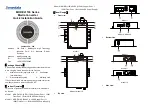
Function-Decoders MX681, MX685, MX686, MX687, MX688 Page 11
Example 1: A couple of
red taillights
are connected to function outputs FO1 and FO2 (front and
rear). Both are to be actuated with F1 but should also change direction-dependently. This requires the
following CV settings:
CV #35 = 12 (Bit 2 for FO1 and Bit 3 for FO2), as well as
CV #127 = 1 (for FO1) and CV #128 = 2 (for FO2).
therefore FO1 is only activated in forward direction and FO2 only in reverse, and only if the function is
turned ON with the function key F1.
Example 2:
Contrary to example 1 where the red taillights were switched independently from the
white headlights, in this example the headlights and taillights are switched ON/OFF together at the
proper end of the locomotive with F0 or F1 (depending on which end the loco is coupled to the train).
This can be done as follows:
Connect: White f
ront headlights to function output “front headlights”
Red front taillights to function output FO2
White rear headlights to function output FO1
R
ed rear taillights to function output “rear headlights”.
CV #33 = 1 and CV #34 = 8 front white headlights on F0forw and front red taillights on F0rev
CV #35 = 6 both white headlights as well as red taillights in the rear on F1
CV #126 = 1 / CV #127 = 2 (Direction dependence for rear white and red lights by means
of “Special
Effects” CV).
Alternative method:
CV’s #107, #108 for “One-sided light suppression”, see below!
3.9
“Unilateral Light Suppression”
This is another feature, asked for by many users, that makes it possible to switch off all lighting on
one side of a locomotive per
one function key (usually on the “train side”, i.e. where cars are coupled
to the locomotive).
CV
Denomination
Range
Default
Description
#107
Light suppression
(i.e. front headlights
AND additionally de-
fined function output)
at
cab side 1 (front)
0 - 255
0
The value of this CV is calculated as follows:
The number of a function output (FO1…FO28)
x
32
+
number of a function key (F1, F2…F28)
=
Value of CV #107
Function Key: That key (F1…F28) which should turn
off ALL lights on the cab side 1 (front side) AND
Function Output: i.e. taillights on the same side.
#108
Cab side 2 (rear)
0 - 255
0
Same as CV #107 but for other locomotive side.
3.10
The “Swiss Mapping”
(SW version 32 and later)
The “Swiss mapping” is a function mapping that allows the loco lighting to be used as required by
Swiss prototypical locomotives, which of course is also useful for locos of other countries.
The purpose of the "Swiss mapping" is to switch various states of the locomotive lighting with different
function keys, i.e. for situations like driving a single locomotive, cars coupled on driver’s cab 1, or at
the driver's cab 2, push-pull, shunting, etc.
Using this relatively complex method is of course only expedient if the vehicle is equipped with many
independently connected lights (or LED’s) and the decoder offers as many function outputs (it should
at least be 6). ZIMO decoders indeed offer between 6 and 10 function outputs (with the exception of a
few miniature decoders), large-scale decoders even more.
The desired lighting states are defined by
a total of 17
CV groups, each group containing 6 CV’s
(CV #430 - #477). The principle is simple in itself, in that the first CV of each group contains the num-
ber (1 to 28) for a function key F1 .. F28, and the other CVs define which function outputs are to be
switched on when pressing this key, each dependent on the direction of travel.
CV
Denomination
Range
Default
Description
#430
Swiss Mapping Group 1
“F-Key”
0 - 28,
29
(for F0),
129 - 157
0
The key defined here shall turn on the function outputs
listed under
A1 (forward or reverse) and
A2 (forward or reverse).
1
– 28 for function keys F1 – F28, F29 is for F0.
Bit 7 = 1: Inverts the F-key function.
Bit 6 = Swiss Mapping group applies to secondary ad-
dress.
#431
Swiss Mapping Group 1
“M-Key”
or
Special high-beam
setting
Bit 0 - 6:
0 - 28,
29
(for F0)
and
Bit 7
or 255
0
The “normal function mapping” (according to CVs
#33-#46)
for the “M-key” defined here will be deac-
tivated (that is the assigned outputs)
when the “F-key”
is switched on.
Bit 7 = 1: the outputs listed under A1 and A2 should
only switch ON if the F and M key are ON.
Bit 6 = 1: The M-key outputs shall not be turned OFF
if
the F-key is ON and driving forward.
Bit = 5: The M-key outputs shall not be turned OFF if
the F-key is ON and driving backwards.
=
157
: is an often used value for this CV, because
F0 (= 29) is usually selected as the “M-key” with
Bit 7 = 1. F0 then acts as a general ON/OFF key.
= 255 (Special
high-beam
setting!): the Fu-Outputs
defined in the following four CVs are switched to full
intensity, provided that they are controlled via the
"normal function mapping", and dimmed with CV #60;
this function is used, for example, to switch the head-
lights of a Swiss locomotive to high-beam, without
switching the white taillight to high-beam.
Depending on CV #399 setting: High beam is only
switched on if the speed is higher than the value given
in this CV.



































